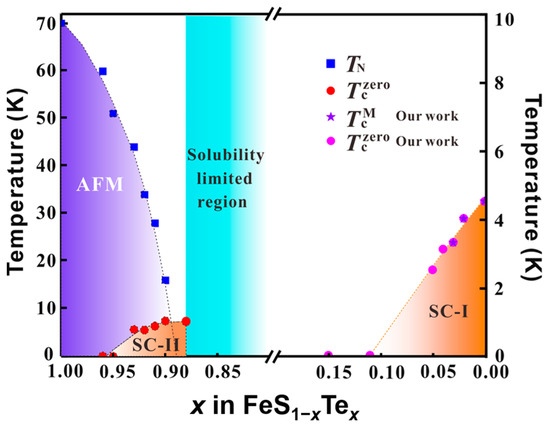You're using an outdated browser. Please upgrade to a modern browser for the best experience.
Please note this is a comparison between Version 1 by Qiang Hou and Version 2 by Dean Liu.
The 11 system in the iron-based superconducting family has become one of the most extensively studied materials in the research of high-temperature superconductivity, due to their simple structure and rich physical properties. Many exotic properties, such as multiband electronic structure, electronic nematicity, topology and antiferromagnetic order, provide strong support for the theory of high-temperature superconductivity, and have been at the forefront of condensed matter physics in the past decade. One noteworthy aspect is that a high upper critical magnetic field, large critical current density and lower toxicity give the 11 system good application prospects.
- single crystal
- hydrothermal
- CVT
- self-flux
- 11 iron-based superconductors
- superconductivity
1. Introduction
The discovery of iron-based superconductivity represents a significant breakthrough in the field of condensed matter physics, with a profound impact on the study of high-temperature superconductivity [1][2][1,2]. According to the different types and ratios of elements in the parent compositions, it can be divided into several different types, such as 111, 122 and 1111 of the iron-pnictide superconductors and 11 and 122 of the iron-chalcogenide superconductors. These materials exhibit a wide range of fascinating physical phenomena, including a multi-band structure, an extremely small Fermi energy, and the presence of nematic and antiferromagnetic (AFM) ordered states. These unconventional superconducting properties make them prime candidates for exploring high-temperature superconductivity and its related properties [3][4][5][3,4,5]. Importantly, the unconventional superconductivity observed in iron-based materials cannot be explained by the conventional electron–phonon pairing mechanism. This breakthrough challenges the notion that cuprates are the sole class of high-temperature superconductors, thereby stimulating further research into the pairing mechanisms underlying high-temperature superconductivity [6][7][8][6,7,8].
Compared with FeAs-based superconductors, the 11 iron-based superconductors in iron-chalcogenide compounds have the advantages of a simple crystal structure and non-toxicity. FeSe consists solely of edge-sharing tetrahedral FeSe4 layers stacked along the c-axis, without a charge storage layer [9][10][11][9,10,11]. A structural transition from tetragonal to orthorhombic occurs at about Ts ~ 90 K accompanied by the nematic phase [12][13][14][15][12,13,14,15]. Despite having a relatively low superconducting critical temperature (Tc) of approximately 9 K, high tunability and nematicity without magnetic order have garnered significant attention and research interest. Under high pressure, the Tc of FeSe can be elevated to approximately 38 K, and a new magnetic order emerges within a specific pressure range once the nematic phase is suppressed [16][17][18][19][16,17,18,19]. Chemical methods, such as intercalation [20][21][20,21], ionic liquid gating [22][23][24][22,23,24] and potassium deposition [25][26][25,26], have been employed to raise the Tc to over 40 K. Remarkably, monolayer FeSe films on doped SrTiO3 substrates have exhibited superconductivity with the Tc surpassing 65 K [27][28][27,28]. These materials offer various pathways to achieve a high Tc and exhibit unconventional superconducting behavior. Consequently, they have become pivotal in advancing research in the field of high-temperature superconductivity, playing a vital role similar to that of copper-based superconductors.
The substitution of isovalent sulfur (S) in FeSe, equivalent to applying positive chemical pressure, has proven to be an effective method for tuning superconductivity and nematic order. With S doping, the nematic transition temperature Ts gradually decreases until it vanishes at x ~ 0.17, marking a nonmagnetic nematic quantum critical point (QCP) [29][30][31][32][29,30,31,32]. Nuclear magnetic resonance (NMR) measurements indicate a strong suppression of AFM fluctuations with S substitution, resulting in negligible AFM fluctuations near the QCP [31]. Within the nematic regions, the Tc exhibits a small superconducting dome, reaching a maximum of 11 K at x ~ 0.11. Beyond the nematic regions, superconductivity is gradually suppressed, reaching a minimum at x ~ 0.45, after which the Tc slowly increases until x = 1 [33]. Notably, unlike when external pressure is applied, no new magnetic order emerges after the nematic phase [33][34][35][33,34,35].
Similarly, the substitution of isovalent tellurium (Te) in FeSe, equivalent to applying negative chemical pressure, is an effective method for tuning the superconductivity and various ordered states. In FeSe1−xTex single crystals phase diagram, Ts linearly decreases until it disappears at x = 0.5 with Te doping [36][37][38][36,37,38]. The Tc initially decreases to a minimum at x ~ 0.3 and then increases to a maximum at x ~ 0.6; subsequently, the Tc is gradually suppressed and antiferromagnetic behavior emerges when x > 0.9 [36][37][39][40][41][42][36,37,39,40,41,42]. FeTe undergoes a tetragonal-to-monoclinic structural transition at around 70 K, exhibiting AFM behavior without superconductivity, reminiscent of the emergence of superconductivity from AFM in the cuprate superconductors [43][44][45][46][47][43,44,45,46,47]. The unique phase diagram of 11 iron-based superconductors, with its interplay of competing orders, nematic phase, magnetic order and superconductivity, provides important insights for exploring the mechanism of high-temperature superconductivity.
Unfortunately, preparing high-quality single crystals is one of the challenges in the study of the 11 iron-based superconducting system, particularly FeSe1−xTex and FeSe1−xSx. This difficulty is also commonly encountered in the study of other iron-based superconducting families. On the one hand, the low chemical stability of FeSe1−xSx and the issue of phase separation in FeSe1−xTex (0 < x < 0.5) make it arduous to obtain single crystals or single-phase samples using traditional solid-state reactions [48][49][50][51][52][48,49,50,51,52]. On the other hand, even though the preparation of single crystals of FeSe1−xTex (0.5 ≤ x ≤ 1) is relatively straightforward using the self-flux method, the presence of excess Fe significantly affects the investigation of their intrinsic properties, such as the localization of charge carriers [53][54][55][53,54,55], spin glass phase [56] and incoherent electronic states [54][57][54,57]. It is difficult to prepare high-quality single crystals of the 11 system using traditional solid-state reaction methods, and new methods are gradually developed.

